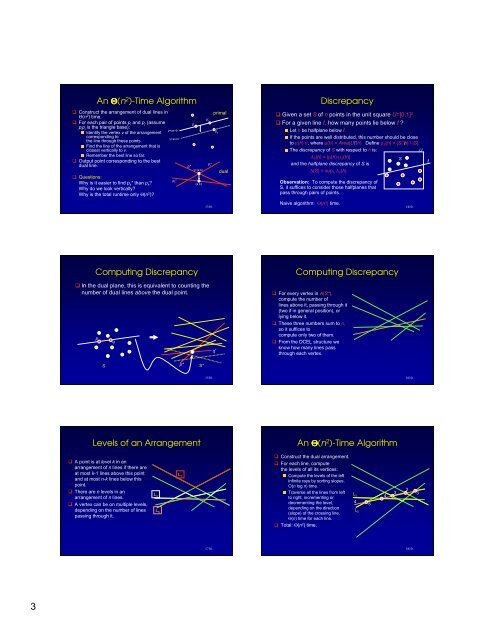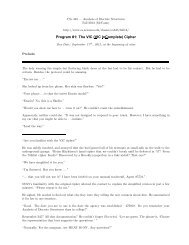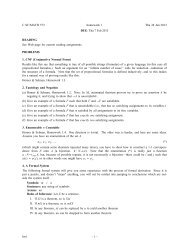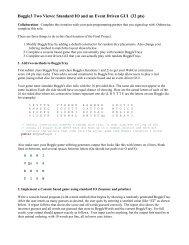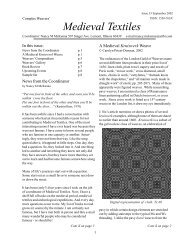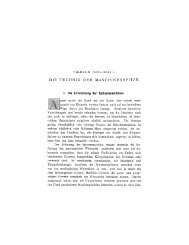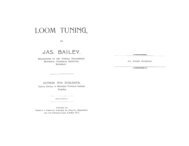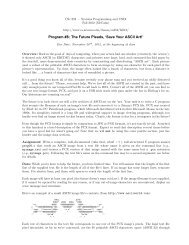Line Arrangement
Line Arrangement
Line Arrangement
You also want an ePaper? Increase the reach of your titles
YUMPU automatically turns print PDFs into web optimized ePapers that Google loves.
l<br />
An Θ(n 2 )-Time Algorithm<br />
Construct the arrangement of dual lines in<br />
Θ(n 2 ) time.<br />
For each pair of points p i and p j (assume<br />
p i p j is the triangle base):<br />
Identify the vertex v of the arrangement<br />
corresponding to<br />
the line through these points.<br />
Find the line of the arrangement that is<br />
closest vertically to v.<br />
Remember the best line so far.<br />
Output point corresponding to the best<br />
dual line.<br />
Questions:<br />
Why is it easier to find p k * than p k ?<br />
Why do we look vertically?<br />
Why is the total runtime only Θ(n 2 )?<br />
y=ax+b<br />
y=ax+b’<br />
p k *<br />
p i *<br />
p i<br />
p j<br />
p k<br />
v=(a,b)<br />
(a,b’)<br />
p j *<br />
1310.<br />
primal<br />
dual<br />
Discrepancy<br />
Given a set S of n points in the unit square U=[0,1] 2 .<br />
For a given line<br />
l, how many points lie below<br />
l?<br />
Let h be halfplane belowl.<br />
If the points are well distributed, this number should be close<br />
to µ(h)·n, where µ(h) = Area(U∩h). Define µ S (h) = |S∩h| / |S|.<br />
The discrepancy of S with respect to h is:<br />
U<br />
∆ S (h) = |µ(h)-µ S (h)|<br />
S<br />
and the halfplane discrepancy of S is<br />
∆(S) = sup h ∆ S (h)<br />
Observation: To compute the discrepancy of<br />
S, it suffices to consider those halfplanes that<br />
pass through pairs of points.<br />
Naive algorithm: Θ(n 3 ) time.<br />
1410.<br />
Computing Discrepancy<br />
In the dual plane, this is equivalent to counting the<br />
number of dual lines above the dual point.<br />
p<br />
q<br />
p*<br />
S S*<br />
q *<br />
Computing Discrepancy<br />
For every vertex in A(S*),<br />
compute the number of<br />
lines above it, passing through it<br />
(two if in general position), or<br />
lying below it.<br />
These three numbers sum to n,<br />
so it suffices to<br />
compute only two of them.<br />
From the DCEL structure we<br />
know how many lines pass<br />
through each vertex.<br />
1510.<br />
1610.<br />
Levels of an <strong>Arrangement</strong><br />
An Θ(n 2 )-Time Algorithm<br />
A point is at level k in an<br />
arrangement of n lines if there are<br />
at most k-1 lines above this point<br />
and at most n-k lines below this<br />
point.<br />
There are n levels in an<br />
arrangement of n lines.<br />
A vertex can be on multiple levels,<br />
depending on the number of lines<br />
passing through it.<br />
L 1<br />
Construct the dual arrangement.<br />
For each line, compute<br />
the levels of all its vertices:<br />
Compute the levels of the left<br />
infinite rays by sorting slopes.<br />
O(n log n) time.<br />
Traverse all the lines from left<br />
to right, incrementing or<br />
decrementing the level,<br />
depending on the direction<br />
(slope) of the crossing line.<br />
Θ(n) time for each line.<br />
Total: Θ(n 2 ) time.<br />
L 3<br />
L 5<br />
1810.<br />
L 3<br />
4<br />
L 5<br />
5<br />
4<br />
3<br />
2<br />
3<br />
1710.<br />
3


